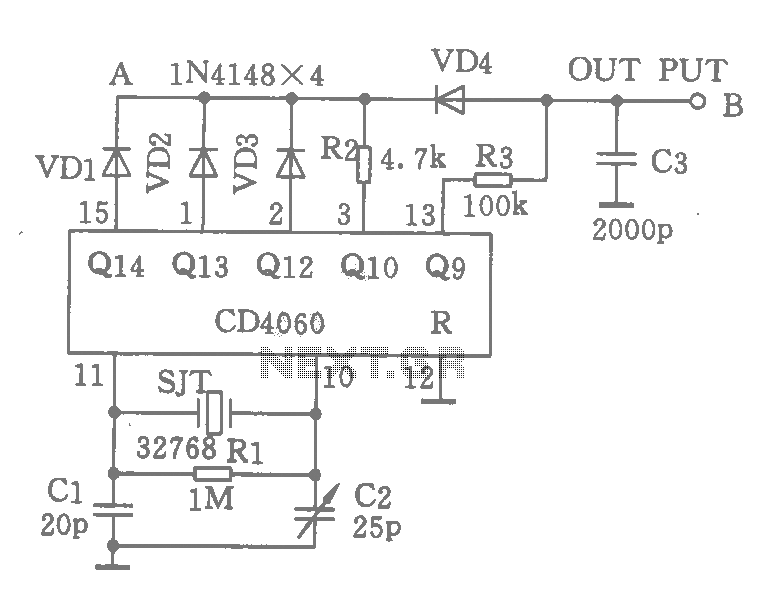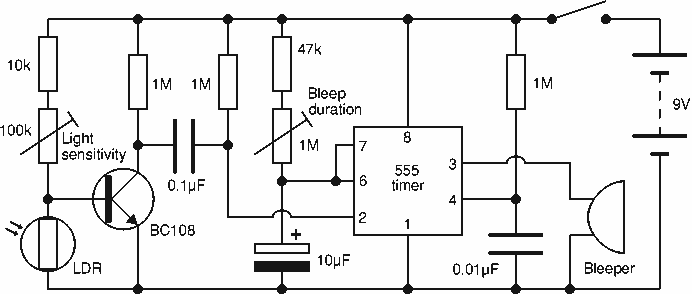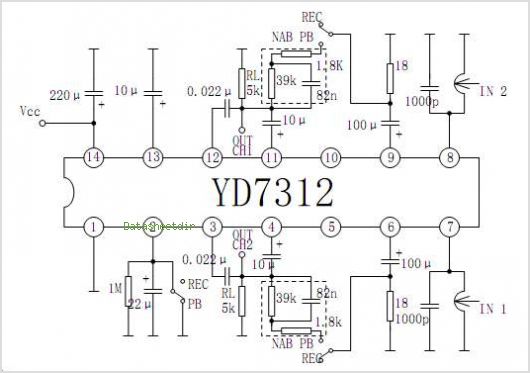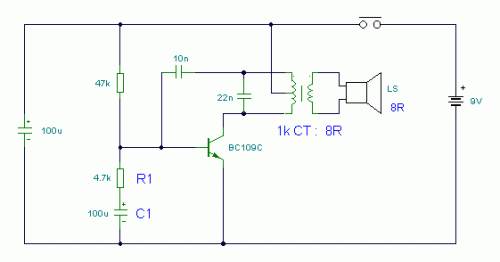
tuned sine wave oscillator circuit

This design circuit functions as a sine wave oscillator, providing both sine and square wave outputs across a frequency range from below 20 Hz to above 20 KHz. The oscillation frequency can be easily adjusted by varying a single resistor. The circuit is managed by two operational amplifiers, LM111 and LM101A. An operational amplifier serves as a tuned circuit, driven by a square wave from a voltage comparator. The frequency is controlled by resistors R1, R2, and R3, as well as capacitors C1 and C2, with R3 specifically used for tuning. The tuning of the filter does not influence its gain or bandwidth, ensuring that the output amplitude remains constant across frequencies. A comparator receives the sine wave output to generate a square wave, which is then fed back to the input of the tuned circuit to facilitate oscillation. A Zener diode, D1, stabilizes the amplitude of the square wave fed back to the filter input. The circuit starts reliably due to R6 and C5, which provide DC negative feedback around the comparator, maintaining it in the active region.
The sine wave oscillator circuit is designed to generate stable sine and square wave outputs over a wide frequency range, making it suitable for various applications in signal generation and testing. The use of LM111 and LM101A operational amplifiers allows for precise control over the waveform characteristics. The tuning components, R1, R2, R3, C1, and C2, form a feedback network that determines the oscillation frequency. The resistor R3 is particularly critical for fine-tuning, enabling the user to achieve the desired frequency without affecting the overall gain or bandwidth of the circuit.
The operational amplifier's role as a tuned circuit is essential, as it processes the square wave signal generated by the comparator. The feedback loop created by the square wave allows for sustained oscillation, while the Zener diode D1 ensures that the feedback signal remains within a stable amplitude range, preventing distortion in the output waveforms. The combination of R6 and C5 not only assists in initiating the oscillation process but also ensures that the comparator operates effectively within its linear range, promoting consistent performance.
This oscillator circuit is versatile and can be utilized in various applications, including audio signal generation, waveform shaping, and as a clock source for digital circuits. The ability to generate both sine and square waves allows for a wide range of testing and operational scenarios, making this circuit a valuable tool for electronic engineers and designers.This is a design circuit for sine wave oscillators that will provide both a sine and square wave output for frequencies from below 20 Hz to above 20 KHz. The frequency of oscillation is easily tuned by varying a single resistor. This circuit is controlled by two op amp, LM111 and LM101A. This is the figure of the circuit. In this circuit, an opera tional amplifier has function as a tuned circuit, driven by square wave from a voltage comparator. The frequency is controlled by R1, R2, C1, C2, and R3, with R3 used for tuning. Tuning the filter does not affect its gain or bandwidth so the output amplitude does not change with frequency. A comparator is fed with the sine wave output to obtain a square wave. The square wave is then fed back to the input of the tuned circuit to cause oscillation. Zener diode, D1, stabilizes the amplitude of the square wave fed back to the filter input. Starting is insured by R6 and C5 which provide dc negative feedback around the comparator. This keeps the comparator in the active region. [Schematic diagram source: National Semiconductor. Inc] 🔗 External reference
The sine wave oscillator circuit is designed to generate stable sine and square wave outputs over a wide frequency range, making it suitable for various applications in signal generation and testing. The use of LM111 and LM101A operational amplifiers allows for precise control over the waveform characteristics. The tuning components, R1, R2, R3, C1, and C2, form a feedback network that determines the oscillation frequency. The resistor R3 is particularly critical for fine-tuning, enabling the user to achieve the desired frequency without affecting the overall gain or bandwidth of the circuit.
The operational amplifier's role as a tuned circuit is essential, as it processes the square wave signal generated by the comparator. The feedback loop created by the square wave allows for sustained oscillation, while the Zener diode D1 ensures that the feedback signal remains within a stable amplitude range, preventing distortion in the output waveforms. The combination of R6 and C5 not only assists in initiating the oscillation process but also ensures that the comparator operates effectively within its linear range, promoting consistent performance.
This oscillator circuit is versatile and can be utilized in various applications, including audio signal generation, waveform shaping, and as a clock source for digital circuits. The ability to generate both sine and square waves allows for a wide range of testing and operational scenarios, making this circuit a valuable tool for electronic engineers and designers.This is a design circuit for sine wave oscillators that will provide both a sine and square wave output for frequencies from below 20 Hz to above 20 KHz. The frequency of oscillation is easily tuned by varying a single resistor. This circuit is controlled by two op amp, LM111 and LM101A. This is the figure of the circuit. In this circuit, an opera tional amplifier has function as a tuned circuit, driven by square wave from a voltage comparator. The frequency is controlled by R1, R2, C1, C2, and R3, with R3 used for tuning. Tuning the filter does not affect its gain or bandwidth so the output amplitude does not change with frequency. A comparator is fed with the sine wave output to obtain a square wave. The square wave is then fed back to the input of the tuned circuit to cause oscillation. Zener diode, D1, stabilizes the amplitude of the square wave fed back to the filter input. Starting is insured by R6 and C5 which provide dc negative feedback around the comparator. This keeps the comparator in the active region. [Schematic diagram source: National Semiconductor. Inc] 🔗 External reference





